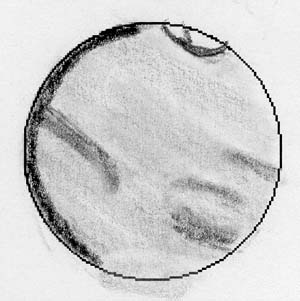
Sketched July 27, 2003 from Glacier Point, Yosemite National Park midnight pacific DST (daylight savings time) or 07:00 UT. Poor observing night until just at midnight. Then we had a nice window of good seeing for my sketch. Transparency LM 5.8, seeing ok from midnight to 1:00 a.m.
| Date: 07/27/03 Lat 37N, Long 119W, elev. 7,200 feet | Sketch Time (UT): 7:00, (local time): midnight DST |
| Central Meridian: 358° | Filters: none |
| Instrument: 7.1-inch (180mm) f/9 Astro-Physics Starfire Apo refractor. | Distance from earth 0.44 AU, 66m km, 41m miles |
| Magnification: (16mm) 300x Zeiss Abbe Orthos combined with a 2.4x AP Barcon Barlow | Transp. 4/6, Seeing 5-7/10, Antoniadi (I-V): II |
| Apparent Size: 21.5" | Magnitude: -2.2 |
Note to self - sketching at a public star party is difficult. South Polar Cap notch and dark melt line continue to be prominent. In fact I decided to make separate sketches of the polar cap from now on. Using the excellent article in the August Sky and Telescope magazine (about the shrinking south polar cap) I was able to identify several features in the polar cap, including a rift. Stay tuned for some polar cap sketches. I also continue to notice a blue haze over the north polar area first seen on July 25, 26, 28. Sinus Sabaeus and Sinus Meridiani continue to be the most visible areas, and are fun to point out. With clouds and then sprinkles before and after a one hour window of observing on our last night at Glacier Point we were delighted to see anything Mars features at all!
Mars, in this sketch is reversed N/S. South is shown at the top of the image. The south polar cap is the prominent feature, and shows a notch that was quite distinct to me. Terminator is where daylight ends and evening begins. The terminator is on the left and the planet is rotating left to right. In my sketches the planet rotates martian east (left) to west (right) to match most other images and sketches. Look for features rotating from left to right in the drawings from night to night.
Details about Mars: Diameter 21.5 arc seconds (Jupiter is about 30 -50 arc seconds in diameter depending on its distance from earth). Central Meridian 358 - the imaginary line passing through the planetary poles of rotation and bisecting the planetary disk, and is used to determine the longitude during an observing session.

White Oaks Home | Sketches Index | Mars 2003 Index | Back | Next